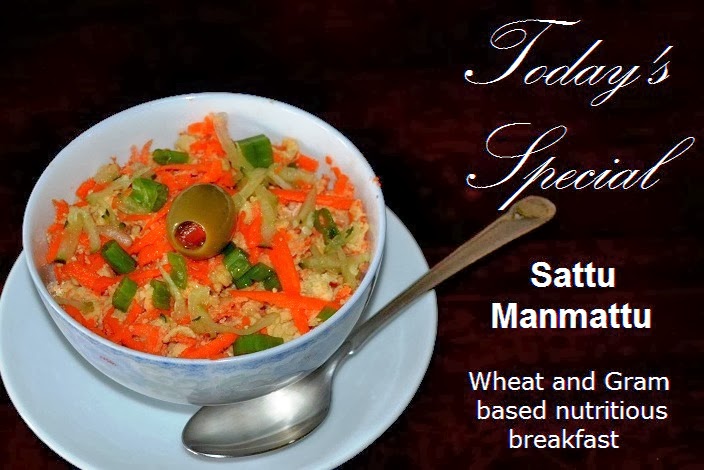Last post was on a simple soothing breakfast. This time it’s
again simple but very healthy breakfast. This again is a non-gas cooking. The
base for the preparation is available all over the northern India, some parts
of east and in Maharashtra. The base that I am going to use is called Sattu.
Sattu is made from roasted Chana (Bengal gram) and roasted
wheat. These two main ingredients are grinded with the skin and mixed with
specific spices like roasted cumin seeds powder, rock salt, in some cases
cardamom etc in a predetermined proportaion. However we don’t have to worry
about preparing the Sattu as there are lots of local brands and generics
available. The problem is one may not get the Sattu in a posh supermarket but
it is definitely available in corner grocery stores. Look for a known brand and
a fresh one. Stale product should be avoided. Get a pack of Sattu and store it
in fridge to preserve its nutritional value.
Sattu has a mention even in Mahabharat. Dronacharya, who was
the Guru of Kaurav and Pandav for martial arts, was very poor (isn’t it sad
that the teachers were underpaid even in that era). He could not afford to buy
milk for his son Ashvathama. The child would ask for milk to his mother and she
would mix Sattu in water and give it to him as milk. The poor child realized
the difference between Sattu and milk only in the later years when Dronacharya
could afford to buy milk (the yearly increments and incentives must have helped
Dronacharya). So Sattu goes back to that era.
There is a saying in Hindi, “Sattu man mattu, chat ghole pat
pile”. (सत्तू मन मट्टू, चट घोले पट पीले) This saying highlights the convenience and versatility of Sattu. It can
be mixed with anything and taken in any form. Sattu can be taken with milk and
sugar with a dash of cardamom or Sattu can be mixed with buttermilk or yoghurt,
salt to taste and dash of spices or just red chili powder. One can make Roti
from Sattu or just temper with oil or Ghee. There are hundreds of ways Sattu
can be taken, even in the form of milkshake or smoothie with desired fruits.
The list is endless.
On the nutritional front, Sattu is a excellent combination
of proteins and carbohydrates, that offers adequate roughage. The roasted grams
give easy to digest proteins with fibers and whole wheat is well for its
nutritional properties. I have to share with you a very easy, highly nutritious
breakfast preparation of Sattu. Just 100 gms (about 3 ozs) of Sattu can provide
enough energy and keep you fit till lunch time. I call the preparation as Sattu
Manmattu. This is how it is to be made.
Take 100 gms of Sattu in a large bowl. Add salt as per your
taste. Please keep in mind that we are going to add few raw vegetables to Sattu
therefore you have to take in to consideration the quantity of vegetables also
while adding salt. Generally we add the salt after mixing the ingredients, but
in this preparation the mixture will become slightly moist and then added salt
may not mix well. That’s the reason I generally add salt before the mixture
becomes moist. To this salted Sattu, now add cupful of grated carrot and grated
cucumber. Add one tablespoonful of olive oil or linseed oil (Flake seed oil) or
any refined oil of your choice. Mix well. The grated cucumber will react with
the salt and the mixture will become moist and that should be fine. Put this
mixed stuff in a serving bowl, garnish with grated cucumber, grated carrot,
chopped spring onion, if you like and coriander. Top it with pitted or stuffed
olive, if available. Before you realize your tasty breakfast is ready. If you
like you may add some herbs like dried basil or spices like freshly crushed
black pepper or chili flakes. This will enhance the taste. In a variation you can
temper the oil with mustard seeds and pour over the mixture instead of just
adding the oil. Whatever you may have it, Sattu Manmattu tastes grate. Enjoy
PS: For the first time “eaters” of Sattu, it is advisable to
keep a glass of water by your side, as Sattu tends to absorb moisture and you
may feel momentary dryness in mouth. A sip of water will make you feel better.





